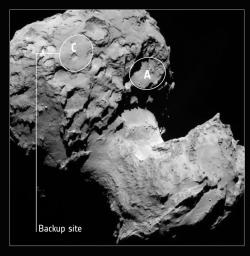
|
Rosetta Lander’s Backup Landing Site
- Click the image above for a larger view
- Full-Res JPEG (1743 x 1787) (292.6 kB)
- Full-Res TIFF (1743 x 1787) (3.1 MB)
Caption:
This annotated image depicts the backup landing site chosen for the Rosetta mission's November landing attempt by its Philae lander. The lander Philae is scheduled to descend to the surface of comet 67P/Churyumov-Gerasimenko on November 11, 2014.
On September 15, 2014, the European Space Agency announced their choice for primary and backup landing sites for the Rosetta mission's Philae lander from a group of five candidate sites.
Landing site C was chosen over other candidate landing sites because of a higher illumination profile and fewer boulders. Candidate site A, seen here in upper right of image, was dismissed as it did not satisfy a number of the key criteria.
The five candidate sites (A, B, C, I and J) were assigned letters based on an original pre-selection of 10 possible sites identified A through J. The lettering scheme does not signify any ranking.
The regions are marked on OSIRIS narrow-angle camera images taken on August 16, 2014, from a distance of about 62 miles (100 kilometers). The comet nucleus is about 2.5 miles (4 kilometers) across.
On September 13, 2014, Site J was chosen as the primary, with Site C as the backup.
Background Info:
The scientific imaging system, OSIRIS, was built by a consortium led by the Max Planck Institute for Solar System Research (Germany) in collaboration with Center of Studies and Activities for Space, University of Padua (Italy), the Astrophysical Laboratory of Marseille (France), the Institute of Astrophysics of Andalusia, CSIC (Spain), the Scientific Support Office of the European Space Agency (Netherlands), the National Institute for Aerospace Technology (Spain), the Technical University of Madrid (Spain), the Department of Physics and Astronomy of Uppsala University (Sweden) and the Institute of Computer and Network Engineering of the TU Braunschweig (Germany). OSIRIS was financially supported by the national funding agencies of Germany (DLR), France (CNES), Italy (ASI), Spain, and Sweden and the ESA Technical Directorate.
Rosetta is an ESA mission with contributions from its member states and NASA. Rosetta's Philae lander is provided by a consortium led by the German Aerospace Center, Cologne; Max Planck Institute for Solar System Research, Gottingen; French National Space Agency, Paris; and the Italian Space Agency, Rome. JPL, a division of the California Institute of Technology, Pasadena, manages the U.S. participation in the Rosetta mission for NASA's Science Mission Directorate in Washington.
For more information on the U.S. instruments aboard Rosetta, visit http://rosetta.jpl.nasa.gov .
More information about Rosetta is available at: http://www.esa.int/rosetta .
Cataloging Keywords:
| Name | Value | Additional Values |
|---|---|---|
| Target | 67P/Churyumov-Gerasimenko | |
| System | Periodic Comets | |
| Target Type | Comet | |
| Mission | Rosetta | |
| Instrument Host | Rosetta Orbiter | Philae Lander |
| Host Type | Orbiter | Lander |
| Instrument | Optical, Spectrocopic and Infrared Remote Imaging System (OSIRIS) | |
| Detector | ||
| Extra Keywords | Grayscale, Infrared | |
| Acquisition Date | ||
| Release Date | 2014-09-15 | |
| Date in Caption | 2014-08-16 | 2014-09-13, 2014-09-15, 2014-11-11 |
| Image Credit | Copyright: ESA/Rosetta/MPS for OSIRIS Team MPS/UPD/LAM/IAA/SSO/INTA/UPM/DASP/IDA | |
| Source | photojournal.jpl.nasa.gov/catalog/PIA18810 | |
| Identifier | PIA18810 | |
